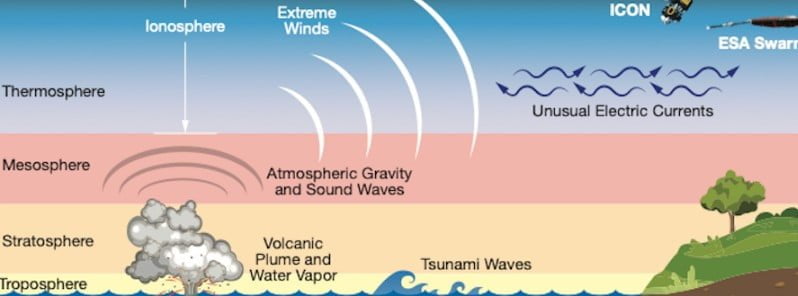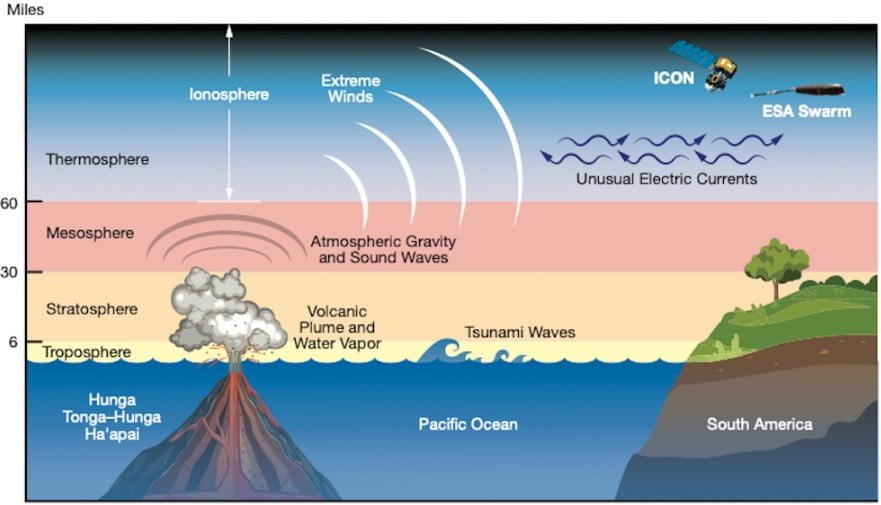Hunga Tonga-Hunga Ha’apai eruption caused a major space weather event

When the Hunga Tonga-Hunga Ha‘apai volcano in Tonga erupted on January 15, 2022, it sent atmospheric shock waves, sonic booms, and tsunami waves around the world. Now, a new research published in Geophysical Research Letters shows the effects of the eruption also reached space, causing a major space weather event.
Analyzing data from NASA’s Ionospheric Connection Explorer (ICON) mission and ESA’s Swarm satellites, scientists found that in the hours after the eruption, hurricane-speed winds and unusual electric currents formed in the ionosphere – Earth’s electrified upper atmospheric layer at the edge of space.
“The volcano created one of the largest disturbances in space we’ve seen in the modern era,” said Brian Harding, a physicist at University of California, Berkeley, and lead author on a new paper discussing the findings.1
“It is allowing us to test the poorly understood connection between the lower atmosphere and space.”
“These results are an exciting look at how events on Earth can affect weather in space, in addition to space weather affecting Earth,” said Jim Spann, space weather lead for NASA’s Heliophysics Division at NASA Headquarters in Washington, D.C.
“Understanding space weather holistically will ultimately help us mitigate its effects on society.”
When the volcano erupted, it pushed a giant plume of gases, water vapor, and dust into the sky. The explosion also created large pressure disturbances in the atmosphere, leading to strong winds.


As the winds expanded upwards into thinner atmospheric layers, they began moving faster. Upon reaching the ionosphere and the edge of space, ICON clocked the windspeeds at up to 725 km/h (450 mph) – making them the strongest winds below 195 km (120 miles) altitude measured by the mission since its launch in 2019.2
ICON’s mission is to identify how Earth’s weather interacts with weather from space – a relatively new idea supplanting previous assumptions that only forces from the Sun and space could create weather at the edge of the ionosphere.
In the ionosphere, extreme winds also affected electric currents. Particles in the ionosphere regularly form an east-flowing electric current – called the equatorial electrojet – powered by winds in the lower atmosphere. After the eruption, the equatorial electrojet surged to five times its normal peak power and dramatically flipped direction, flowing westward for a short period.
“It’s very surprising to see the electrojet be greatly reversed by something that happened on Earth’s surface,” said Joanne Wu, a physicist at the University of California, Berkeley, and co-author on the new study.
“This is something we’ve only previously seen with strong geomagnetic storms, which are a form of weather in space caused by particles and radiation from the Sun.”
In a study published on April 20, Piero Poli et al. estimated the Hunga Tonga’s volcanic explosivity index (VEI) at ~6, placing it among the largest volcanic eruptions ever recorded with modern geophysical instrumentation.3
References:
1 NASA Mission Finds Tonga Volcanic Eruption Effects Reached Space – NASA – May 10, 2022
2 Impacts of the January 2022 Tonga Volcanic Eruption on the Ionospheric Dynamo: ICON-MIGHTI and Swarm Observations of Extreme Neutral Winds and Currents – Brian J. Harding et al. – May 10, 2022 – Geophysical Research Letters – https://doi.org/10.1029/2022GL098577
3 Rapid Characterization of Large Volcanic Eruptions: Measuring the Impulse of the Hunga Tonga Ha’apai Explosion From Teleseismic Waves – Piero Poli et al. – April 20, 2022 – Geophysical Research Letters – https://doi.org/10.1029/2022GL098123
Featured image credit: NASA’s Goddard Space Flight Center/Mary Pat Hrybyk-Keith

Commenting rules and guidelines
We value the thoughts and opinions of our readers and welcome healthy discussions on our website. In order to maintain a respectful and positive community, we ask that all commenters follow these rules.